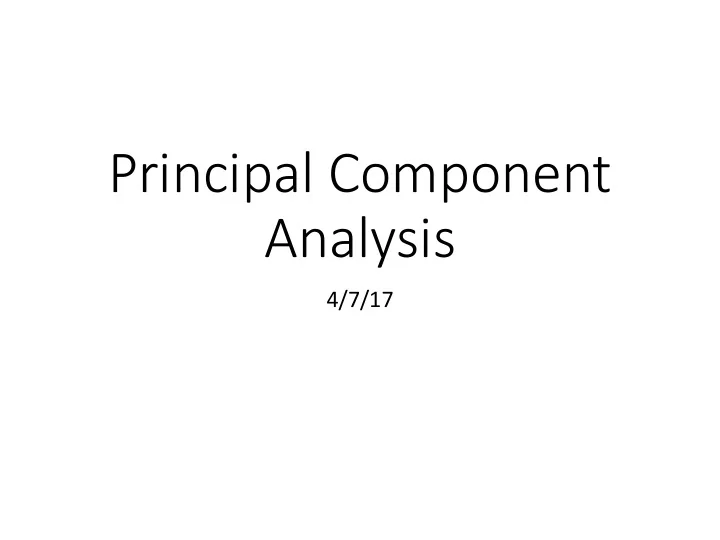

Principal Component Analysis 4/7/17
PCA: the setting Unsupervised learning • Unlabeled data Dimensionality reduction • Simplify the data representation What does the algorithm do? • Performs an affine change of basis. • Rotate and translate the data set so that most of the variance lies along the axes. • Eliminates dimensions with little variation.
Change of Basis Examples So Far Support vector machines • Data that's not linearly separable in the standard basis may be (approximately) linearly separable in a transformed basis. • The kernel trick sometimes lets us work with high- dimensional bases. Approximate Q-learning • When the state space is too large for Q-learning, we may be able to extract features that summarize the state space well. • We then learn values as a linear function of the transformed representation.
Change of Basis in PCA This looks like the change of basis from linear algebra. • PCA performs an affine transformation of the original basis. • Affine ≣ linear plus a constant The goal: • Find a new basis where most of the variance in the data is along the axes. • Hopefully only a small subset of the new axes will be important.
PCA Change of Basis Illustrated
PCA: step one First step: center the data. • From each dimension, subtract the mean value of that dimension. • This is the "plus a constant" part, afterwards we'll perform a linear transformation. • The centroid is now a vector of zeros. Original Data Centered Data x0 x1 x2 x3 x4 means x0 x1 x2 x3 x4 4 3 -4 1 2 1.2 2.8 1.8 -5.2 -.2 .8 8 0 -1 -2 -5 0 8 0 -1 -2 -5 -2 6 -7 -6 -3 -2.4 .4 8.4 -4.6 -3.6 -.6
PCA: step two The hard part: find an orthogonal basis that's a linear transformation of the original, where the variance in the data is explained by as few dimensions as possible. [0,1] [1,0] Basis: set of vectors that span the dimensions. Orthogonal: all vectors are perpendicular. Linear transformation: rotate all vectors by the same amount. Explaining the variance: low co-variance across dimensions.
PCA: step three Last step: reduce the dimension. • Sort the dimensions of the new basis by how much the data varies. • Throw away some of the less-important dimensions. • Could keep a specific number of dimensions. • Could keep all dimensions with variance above some threshold. • This results in a projection into the subspace of the remaining axes.
Computing PCA (step two) • Construct the covariance matrix. • m x m (m is the number of dimensions) matrix. • Diagonal entries give variance along each dimension. • Off-diagonal entries give cross-dimension covariance. • Perform eigenvalue decomposition on the covariance matrix. • Compute the eigenvectors/eigenvalues of the covariance matrix. • Use the eigenvectors as the new basis.
Covariance Matrix Example C X = 1 nXX T X T 2.8 8 .4 C X = ⅕(X)(X T ) X 1.8 0 8.4 2.8 1.8 -5.2 -.2 .8 -5.2 -1 4.6 7.76 4.8 8.08 8 0 -1 -2 -5 -.2 -2 -5 4.8 18.8 3.6 .4 8.4 -4.6 -3.6 -.6 .8 -5 -.6 8.08 3.6 21.04
Linear Algebra Review: Eigenvectors Eigenvectors are vectors that the matrix doesn’t rotate. If X is a matrix, and v is a vector, then v is an eigenvector of x iff there is some constant λ, such that: • Xv = λv λ, the amount by which X stretches the eigenvector is the eigenvalue. np.linalg.eig gives eigenvalues and eigenvectors.
Linear Algebra Review: Eigenvalue Decomposition If the matrix (X)(X T ) has eigenvectors with eigenvalues for i ∈ {1, …, m}, then the following vectors form an orthonormal basis: The key point: computing the eigenvectors of the covariance matrix gives us the optimal (linear) basis for explaining the variance in our data. • Sorting by eigenvalue tells us the relative importance of each dimension.
PCA Change of Basis Illustrated Center the data by Re-align the data by subtracting the mean finding an orthonormal in each dimension. basis for the covariance matrix.
When is/isn’t PCA helpful?
Compare Hypothesis Spaces • What other dimensionality reduction algorithm(s) have we seen before? Compare auto-encoders with PCA: • What sorts of transformation can each perform? • What are advantages/disadvantages of each?
Auto-Encoders Idea: train a network for data compression/ dimensionality reduction by throwing away outputs. target training hidden layer becomes = input the output input 2 2 -1 -1 0 0 1 1 3 3
Recommend
More recommend